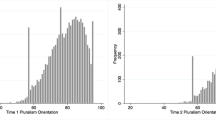Abstract
The basic theory of Rasch measurement applies to situations where a person has a certain level of a trait being investigated, and this level of ability is what determines (to within a measurement error) how well the person does on each item in a test. This paper responds to frequent suggestions from colleagues that the use of Rasch measurement would be profitable in analysing a set of data on students’ understanding of decimal notation. We demonstrate misfit to the Rasch model by showing that item difficulty estimates show important variation by year level, that there is significant deviation from expected score curves, and that success on certain splitter items does not imply a student is more likely to score well on other items. The explanation given is that conceptual learning may not always be able to be measured on a scale, which is an essential feature of the Rasch approach. Instead, students move between categories of interpretations, which do not necessarily provide more correct answers even when they are based on an improved understanding of fundamental principles. In this way, the paper serves to highlight the assumptions built into the Rasch model and to discuss its applicability to describing the progress of learning with various characteristics.
Similar content being viewed by others
References
Adams, R. J., & Khoo, S. T. (1993). Quest: The Interactive Test Analysis System. [Computer software]. Melbourne: Australian Council for Educational Research.
Bond, T. G., & Fox, C. M. (2001).Applying the Rasch Model: Fundamental measurement in the human sciences. Mahwah, NJ: Lawrence Erlbaum.
Nicholson, A., Boneh, T., Wilkin, T., Stacey, K., Sonenberg, E., & Steinle, V. (2001). A case study in knowledge discovery and elicitation in an intelligent tutoring application. In J. Breese & D. Koller (Eds.),Proceedings of the 17th conference on Uncertainty in Artificial Intelligence (pp. 386–394). San Francisco: Morgan Kaufmann.
Programme for International Student Assessment (PISA). (2005).PISA 2003 technical report. Paris: Organisation for Economic Co-operation and Development.
Stacey, K., & Steinle, V. (1998) Refining the classification of students’ interpretations of decimal notation.Hiroshima Journal of Mathematics Education.6, 49–69.
Stacey, K. (2005). Travelling the road to expertise: A longitudinal study of learning. In H. L. Chick & J. L. Vincent (Eds.)Proceedings of the 29th annual conference of the International Group for the Psychology of Mathematics Education (Vol. 1, pp. 19–36). Melbourne: PME.
Steinle, V. (2004).Changes with age in students’ misconceptions of decimal numbers. Unpublished PhD thesis, University of Melbourne, Australia.
Steinle, V., & Stacey, K. (1998). The incidence of misconceptions of decimal notation amongst students in grades 5 to 10. In C. Kanes, M. Goos, & E. Warren (Eds.),Teaching mathematics in new times. (Proceedings of the 21st annual conference of the Mathematics Education Research Group of Australasia, Vol. 2, pp. 548–555). Gold Coast, QLD: MERGA.
Steinle, V., & Stacey, K. (2003). Grade-related trends in the prevalence and persistence of decimal misconceptions. In N. A. Pateman, B. J. Dougherty & J. Zilliox (Eds.),Proceedings of the 27th annual conference of the International Group for the Psychology of Mathematics Education (Vol. 4, pp. 259–266). Honolulu: PME.
Swaminathan, H. (1999). Latent trait measurement models. In G. N. Masters, & J. P. Reeves (Eds.),Advances in measurement in educational research and assessment (pp. 43–54). Oxford: Pergamon.
TIMSS-R.IEA’s Repeat of the Third International Mathematics and Science Study at the Eighth Grade. Retrieved August 30, 2005, from http://timss.bc.edu/timss1999i/pdf/t99math_items.pdf
Wu, M. L., Adams, R. J., & Wilson, M. R. (1997). ConQuest: Multi-Aspect Test Software [Computer software]. Melbourne: Australian Council for Educational Research.
Author information
Authors and Affiliations
Rights and permissions
About this article
Cite this article
Stacey, K., Steinle, V. A case of the inapplicability of the Rasch model: Mapping conceptual learning. Math Ed Res J 18, 77–92 (2006). https://doi.org/10.1007/BF03217437
Issue Date:
DOI: https://doi.org/10.1007/BF03217437




